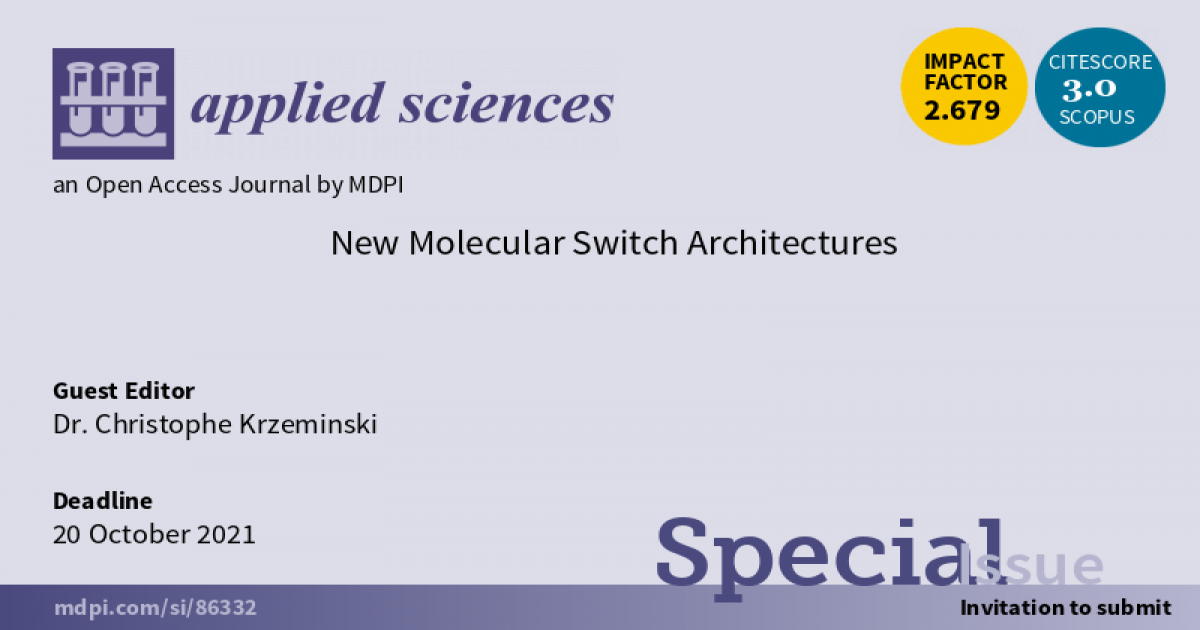New Molecular Switch Architectures
A special issue of Applied Sciences (ISSN 2076-3417). This special issue belongs to the section "Nanotechnology and Applied Nanosciences".
Deadline for manuscript submissions: closed (20 October 2021) | Viewed by 475

Special Issue Editor
2. IEMN - Central Laboratory of the Institute, CNRS, Cité Scientifique, Avenue Henri Poincaré, CS 60069, 59652 Villeneuve d'Ascq Cedex, France
Interests: modeling in nanotechnology
Special Issue Information
Dear colleagues,
The seminal view of Richard Feynman that "there is plenty room at the bottom" has probably never actually made much sense in terms of understanding the physical phenomena at the nano or meso scale. Some work of the scientific community aims to improve the understanding of physical phenomena in the field of molecular switch and to suggest new material architecture. One of the main scientific objectives is also to develop new functions activated by different optical or chemical stimuli such as memory, sensor or even molecular motor. However, in practice, there is a large number of technological and fundamental obstacles in the way of controlling this opto-molecular transition. The transition from a conductive to a blocked state is governed by thermodynamical and/or thermalization processes linked to the activation barrier of the different states of the molecule. The assembly, the organization or the grafting on a surface of these molecular complex materials lay some structural problems in terms of steric hindrance and free volume. Finally, the various optical, mechanical or electrical characterization at the nanoscale linked with different levels of concepts or scientific modeling trigger a better insight into the architecture and properties of these molecular switch.
Therefore, the aim of this Special Issue is to expand the current knowledge in the field and gather high-quality papers dealing with the architecture and the properties of the molecular switch.
Dr. Christophe Krzeminski
Guest Editor
Manuscript Submission Information
Manuscripts should be submitted online at www.mdpi.com by registering and logging in to this website. Once you are registered, click here to go to the submission form. Manuscripts can be submitted until the deadline. All submissions that pass pre-check are peer-reviewed. Accepted papers will be published continuously in the journal (as soon as accepted) and will be listed together on the special issue website. Research articles, review articles as well as short communications are invited. For planned papers, a title and short abstract (about 100 words) can be sent to the Editorial Office for announcement on this website.
Submitted manuscripts should not have been published previously, nor be under consideration for publication elsewhere (except conference proceedings papers). All manuscripts are thoroughly refereed through a single-blind peer-review process. A guide for authors and other relevant information for submission of manuscripts is available on the Instructions for Authors page. Applied Sciences is an international peer-reviewed open access semimonthly journal published by MDPI.
Please visit the Instructions for Authors page before submitting a manuscript. The Article Processing Charge (APC) for publication in this open access journal is 2400 CHF (Swiss Francs). Submitted papers should be well formatted and use good English. Authors may use MDPI's English editing service prior to publication or during author revisions.
Keywords
- nanotechnology
- molecular material
- molecular switch
- non-von Neumann architecture
- optical
- chemical sensor
- molecular motor
- nanometric and optical spectroscopy
- first principles or empirical modeling
Benefits of Publishing in a Special Issue
- Ease of navigation: Grouping papers by topic helps scholars navigate broad scope journals more efficiently.
- Greater discoverability: Special Issues support the reach and impact of scientific research. Articles in Special Issues are more discoverable and cited more frequently.
- Expansion of research network: Special Issues facilitate connections among authors, fostering scientific collaborations.
- External promotion: Articles in Special Issues are often promoted through the journal's social media, increasing their visibility.
- e-Book format: Special Issues with more than 10 articles can be published as dedicated e-books, ensuring wide and rapid dissemination.
Further information on MDPI's Special Issue polices can be found here.





